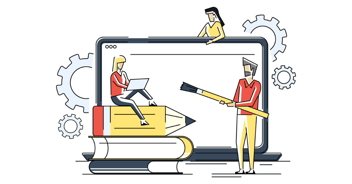Email invite. Ad campaign. Registration. Email reminder. No-shows. Cold leads. Repeat.
Sound familiar?
If you’ve used webinars as part of your B2B public relations strategy, you may have noticed a distressing trend: it’s getting harder and harder to get people to sign up for and attend webinars.
Don’t worry, the problem isn’t you. It’s webinar fatigue.
Many, many brands incorporate webinars into their marketing efforts today, and since the start of the COVID pandemic the number of webinars has increased dramatically.Unfortunately, a lot of those webinars are bad. Boring. Low-value. The more bad webinar experiences a person has, the less likely they are to sign up for future ones.
The good news is that you can stand out from the crowd and overcome webinar fatigue. Let’s look at exactly how to do it.
What is webinar fatigue?

First, let’s make sure we’re all on the same page regarding the term “webinar fatigue”. When webinars were first introduced, they were the go-to option for many businesses. They offered a relatively easy way to reach a wide audience and the setup was fairly simple.
Unfortunately, many people are starting to experience webinar fatigue. Webinar fatigue is what happens when a person attends a significant number of webinars and no longer feels like they are getting value from them. As a result, they either don't attend webinars they've registered for or don't register at all.
While this may seem like bad news for business owners who use webinars as one of their marketing strategies, it doesn't have to be. We'll talk about some ways to overcome webinar fatigue in a moment.
What causes webinar fatigue?

There are a number of causes of webinar fatigue. One cause is a lack of personalization. If you're running the same webinar for all of your prospects, then a significant amount of the information might not be relevant to segments of your audience.
Webinars are meant to be personalized to suit your prospect's needs. They are supposed to answer their questions, help them overcome challenges, and leave them with valuable takeaways. If your webinars aren't tailored for the attendees, they'll feel like it's a waste of time.
Another possible reason for webinar fatigue is that your webinars are stale and boring. If your webinar feels like one long PowerPoint presentation, it's not going to hold people's interest. Your drop-off rate will be high and very few people will stick around to the end.
Being too salesy can also contribute to webinar fatigue. Salesy webinars focus too much on your product or service and not enough on delivering value to the attendees. Nobody wants to sit through a 45-minute sales pitch. It's fine to do a little promotion, but the main focus should be on giving value to attendees.
A final cause of webinar fatigue is that you're targeting the wrong audience. If you're trying to sell a product that isn't relevant to their business goals, they're not going to be interested in it. You'll only be wasting their time by giving them information that doesn't help them.
How To Overcome Webinar Fatigue
Thankfully, there are specific strategies you can use to overcome webinar fatigue, encourage people to sign up, and keep attendees engaged throughout the event.
1. Connect with your audience
One effective way to combat webinar fatigue is to make an effort to connect with your audience. Connecting with your audience is important because it helps you develop a relationship with them, which causes them to be more interested in what you have to say.
Some simple ways to connect with your audience include:
- Making the webinar interactive and personal. Your webinar shouldn't be a monologue. Ask questions and invite attendees to respond in the chat box. Take polls to find out what people's challenges or desires are. Interaction helps people stay engaged.
- Don't just read off your slides. Share what you know about the topic, and don't be afraid to interject with a personal experience or anecdote that will help make it more relatable for the audience.
- Use occasional pop culture references. Throw in a movie reference or line from a popular song. The business world tends to be pretty sterile and boring. Occasionally referencing pop culture grabs people's attention.
2. Keep things concise
It's really important to not waste people's time. People get bored by long-winded presentations that include too much filler and fluff. To put it another way, say what you need to say but not anything more.
Many webinars are lengthy because they're trying to cover too much content. People can only process so much information at one time. When preparing your webinars, have a clear message with a specific goal. It's a good idea to create an outline for the content and then fill in each section based on what you want to talk about. This will help you stay organized as well as make sure that all of your points are covered so that no one leaves feeling like they didn't get their questions answered or heard properly.
Also, if your webinar includes more than just you, choose speakers who are engaging and passionate about what they're talking about. This will keep your audience engaged and interested in what they have to say.
One option is to use short webinars as a way to get prospects interested in how you can help solve their challenges and then offer another, longer webinar that goes into more detail about the product or service.
3. Thoroughly prepare in advance

We touched on this earlier, but it bears repeating. The best way to make your webinar as engaging as possible is to prepare in advance. Do your research beforehand, have all of your materials at hand, and know what you're going to say before the presentation starts. Remember that you need to be succinct but also provide enough detail for people to understand what you're saying. And don't forget about visual aids. Using images, videos, and diagrams can help illustrate the concepts more clearly for those who are watching.
Also, when preparing for the webinar, make sure that you know who is attending and spend time researching their interests and needs. The more prepared you are, the more attendees will feel engaged with your content.
Additionally, it can be very helpful to practice your presentation beforehand and then look for ways to improve. This will help you be more familiar with the material and keep the whole webinar running smoothly.
4. Keep your slides simple
It's important to keep your slides simple and concise. You don't want to overwhelm your audience with too much information, so break up your points into digestible chunks.
Generally speaking, you should include only one main point per slide. The text should be easy to read and not a long paragraph. You want your presentations to be scannable and easy on the eyes. Try to avoid gaudy colors or designs that distract from the content on the slides.
Tools like Slideshare, Canva, and Venngage make it really easy to design aesthetically pleasing slides. You can simply use one of their pre-made templates and then customize to fit your brand.
5. Include different types of media
Using media other than just text can be an effective way to keep the attention of attendees. It helps keep prospects interested in what you say and reinforces the information you're presenting.
Consider using these things:
- Images
- Quotes
- Short video clips
- Charts/graphs
- Infographics
- Memes (if appropriate for the audience)
Consider using multimedia storytelling throughout your presentation. That helps to break up the webinar and grabs people's attention. In addition to making it easy to create great slides, Canva and Venngage are also great tools for creating images.
6. Lay out the agenda at the beginning
Another helpful way to overcome webinar fatigue is to clearly lay out what you'll be covering during the webinar. This can include a list of topics, who else will be on the webinar (if applicable), and how long it will last. It's important that your audience knows what to expect at the beginning of the webinar. If they don't, there's a greater probability that they'll stop watching before the end.
7. Use humor to make it more interesting

Webinars have a reputation for being pretty dry and bland. Humor is an excellent way to spice things up, grab people's attention, and make them feel like they're part of the conversation. If you can make your prospects laugh, then they'll be more likely to remember what you said and enjoy the overall experience.
You don't have to be a stand-up comedian to use humor. You can tell a funny story, include a humorous quote, reference a movie scene, or even make fun of yourself in a lighthearted way.
The only caveat is to make sure the humor you use matches your audience. A 25-year old millennial at the beginning of their career has a very different sense of humor than a 55-year old top-level executive. Using a quote from The Hangover might (emphasis on "might") be appropriate for the first audience, but it probably wouldn't fly for the second. You have to walk the line between being funny while also being appropriately professional.
And to state the obvious, stay away from anything remotely controversial. Don't make jokes about politics, religion, etc.
8. Get to the content quickly
If you want to beat webinar fatigue, be respectful of people's time. Don't start off your webinar with a prolonged introduction. Instead, give them a quick snapshot of who you are, what the webinar is about, and any relevant credentials you might have.
Ideally, the beginning of your webinar should contain something that immediately grabs people's attention. This is a key moment where you can make an impression on attendees and pique their interest for what's to come. You could speak directly to the challenges or pain points of the attendees. You could tell them that you're going to show them how to achieve a particular goal. The point is that you want to get moving quickly so that you maintain people's interest from the beginning.
9. Express your personality
Don't be afraid to inject your personality into your webinars. It's okay to laugh, be expressive, and generally have a good time. People will appreciate the more human side of you, and it will make you seem more approachable. Plus, if you're having fun, your audience will feel more at ease and be more likely to participate in the conversation.
10. Don't just read the text on the slides
We touched on this earlier but it needs to be emphasized. Nothing is worse than a webinar where the presenter simply reads the text on the slides. Not only is it boring, but it feels like a waste of time. Attendees could get the exact same information just by downloading your slide deck. There's no incentive to stick around.
Instead, put a small amount of text on each slide and then expand upon that text with information from your notes. This will help you to avoid sounding like a robot and will keep the presentation feeling more conversational.
11. Include a Q&A section
By the end of your webinar, some of the attendees will still have questions that weren't addressed during the presentation. In light of this, it's a good idea to include a Q&A section at the end.
This will help you address any lingering questions and also give you an opportunity to connect with your audience on a personal level. Plus, it shows that you're interested in what they have to say, which can make your audience more likely to listen to what you say and take action on the information presented.
12. Share resources that your audience will find useful
As a way of adding even more value to your webinar, provide attendees with helpful supplemental resources. These resources can include:
- Cheat sheets
- Checklists
- eBooks
- Bylined articles
- Free consultation
- Digital courses
- Free trial of product/service
What makes these resources so valuable is that they'll help your audience to take action on the information presented during your webinar. They'll also show that you genuinely care about their success, which will leave a lasting impression and make them more likely to come back for more of your training in the future.
13. Follow up
Finally, it's important to follow up after the webinar, both with attendees and those who signed up but weren't present. The reality is that attendance will probably be between 40 - 50% of those who signed up, with many planning on watching the replay afterwards.
Your follow-up should include a link to the replay, as well as a nurture email sequence designed to help your attendees take action on what they learned during the webinar. You might also want to include a link to an additional resource that complements the content you covered during the live session.
Final Thoughts
Webinar fatigue doesn't have to sabotage your efforts at building an audience and connecting with prospects. Through careful planning, diligent preparation, and a commitment to serve your audience, you can host highly effective webinars that grow your audience, generate leads, and ultimately lead to more revenue.

 11 min read
11 min read





 15 min read
15 min read

